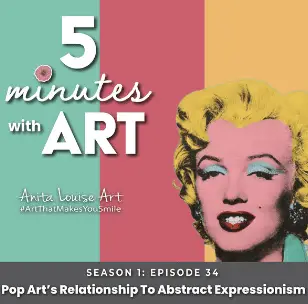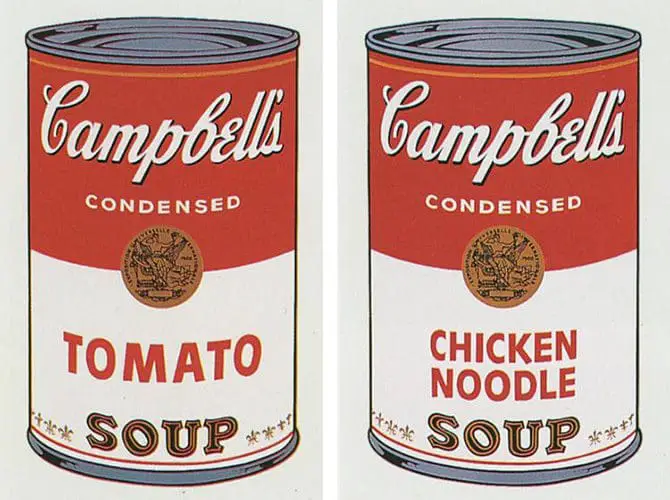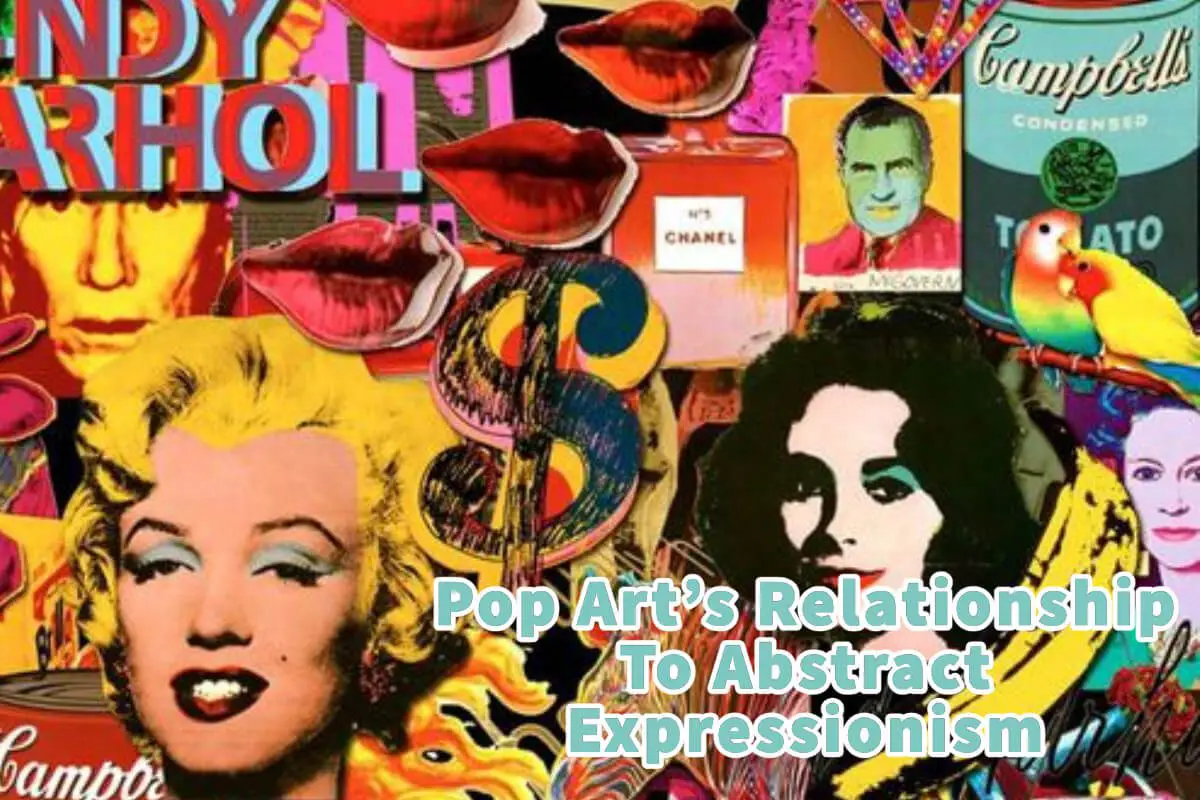Pop Art and Abstract Expressionism are two important yet very different art movements. The art movements are in some ways related to each other.
Pop art is an art movement that started in the United Kingdom and the United States. Pop Art was, to some extent, a reaction to Abstract Expressionism art. Pop art emerged in the 1950s and flourished in the 1960s. Pop Art was inspired by popular culture, commercialization, and mass advertising.
Table of Contents
- Pop Art’s Relationship To Abstract Expressionism Art Movement
- Pop Art Was A Reaction To Abstract Expressionism
- Pop Art Started In The United Kingdom And The United States
- Pop Art In The United Kingdom And The United States Developed Differently
- Pop Art Was Showing A Shift In The World
- Pop Art Used Images From Popular Culture
- Pop Art Showed Commercialization Of Culture
- “Pop Art: The Colorful Revolution of the 20th Century”
- Frequently Asked Questions
- Related Questions
Pop Art’s Relationship To Abstract Expressionism Art Movement
Pop Art and Abstract Expressionism are two major art movements influencing 20th-century art. Because they are both in the 20th century, there is a relationship between them both being 20th Century art movements.
Here are some ways that Pop Art and Abstract Expressionism Art relate.
Pop Art Was A Reaction To Abstract Expressionism
Pop Art is a reaction to what was then becoming the dominant form of art, Abstract Expressionism. Abstract Expressionism and the New York school had taken over the art world at the time.
The world’s art center changed from Paris, France, to New York because of Abstract Expressionism art.
Pop Art Started In The United Kingdom And The United States
Pop art started in the United Kingdom and the United States in the mid to late 1950s. The Pop art movement saw some shift in the world’s artistic center to move back to Europe.
Pop Art In The United Kingdom And The United States Developed Differently
Even though pop art started in North America and Britain, it developed differently. The United States and Britain had different reasons for creating pop art.
In the United States, Pop art was a response by the artists wanting to return to composition and the representation of art. This directly responded to Abstract Expressionism art and how many felt that Abstract Expressionism stopped representing art.
In the United Kingdom, Pop art was about irony and parody. The United Kingdom’s pop art focused on America but viewed it from a distance. It was about how American popular culture and images could influence people’s lives.
Pop Art Was Showing A Shift In The World

Both Pop Art and Abstract Expressionism showed a shift in world culture. The Pop Art movement in the United States and the United Kingdom also showed a cultural change.
Here are a few things to remember about that shift that was happening in the world and, in particular, the United States:
- New Wars – The world had come out of World War II, but the new wars as the Korean War and the very unpopular Vietnam Conflict.
- RocknRoll – Rock n Roll’s new style of music was inspired by the African-American blues and embraced popular themes among teenagers and others.
- Challenge To Values – A challenge to many of the values of the American culture, which are religion, sex, and race. This included that women started to get an education and work outside the home.
- Civil Right Movement – America was in the middle of a civil rights movement with many racial conflicts.
- Hippie Movement – The 1960s saw a hippie movement breaking with many traditional values that many people once thought could never be broken.
- Love, Sex, And Rock’s n Roll – The terms love, sex, and rock ‘n’ roll became part of the American culture. Many hippies moved into communes and believed in free sex along with rock ‘n’ roll.
- Television Was Important – Television started to be important as people began to have a television in their homes that showed many popular shows.
- Advertising Was Important – With the television, advertising also came. New forms of advertising were being shown everywhere.
- More Disposal Income – Many young Americans have disposable income, so they enjoy more material goods. This allows them to devote time to leisure activities and be part of the popular culture’s consumption.
- Civil Disobedience – Civil disobedience was marked during this time: Marches, protests, and disdain for authority.
Abstract Expressionism was the forerunner to the changes that were taking place in the world; Pop Art was right at the heart of many of those changes.

Listen To Our Podcast About Pop Art’s Relationship To Abstract Expressionism by clicking here.
Pop Art Used Images From Popular Culture

Pop art differs from Abstract Expressionism, where artists express their inner feelings on canvas. Instead, Pop Art used images from everyday popular cultures, such as advertising, comic books, and even mass-produced items such as Campbell’s soup cans.
Pop Art Showed Commercialization Of Culture
Pop art is also shown to commercialize a culture. Television was in the homes, commercials everywhere, along with billboards, magazines, and advertisements.
The Pop Artists used images from commercial product packaging and advertising imagery to convey their artistic message.
So even though Abstract Expressionism overlapped with the Pop Art movements, there are some significant differences in this artistic execution and how these two art movements looked and developed.
Most people agree that Pop Art was a reaction to Abstract Expressionism, but both art movements showed that the world we once knew was rapidly changing.
“Pop Art: The Colorful Revolution of the 20th Century”
Emerging in the mid-20th century, Pop Art burst onto the cultural scene, challenging traditional notions of art and embedding itself into the fabric of popular culture. This vibrant and cheeky art movement took inspiration from the every day, turning the mundane into the magnificent.
Delve into the world of Pop Art as we explore ten fascinating facts that encapsulate its allure and significance.
- Origins: Pop Art originated in the 1950s in Britain but quickly gained immense popularity in the United States by the 1960s, reflecting the prevalent consumerist culture.
- Everyday Imagery: Unlike other art movements that often drew from nature or classical themes, Pop Art took its inspiration from everyday items, such as soup cans, comic strips, and advertisements.
- Celebration of Mass Culture: Pop Art celebrated and sometimes critiqued the mass-produced, commercial elements of post-war society, bridging the gap between “high art” and “low art.”
- Leading Figures: Some of the most iconic names associated with Pop Art include Andy Warhol, Roy Lichtenstein, Keith Haring, and Jasper Johns.
- Warhol’s Factory: Andy Warhol’s New York studio, known as “The Factory,” became a cultural hub, bringing together artists, intellectuals, celebrities, and other avant-garde individuals.
- Comic Book Influence: Roy Lichtenstein was renowned for his large-scale reproductions of comic book panels, complete with halftone dots and dramatic lines, elevating them to fine art status.
- Beyond Paint: Pop Art wasn’t limited to paintings. It extended to sculptures, silkscreens, collages, and even performance art.
- Global Impact: While most closely associated with the UK and the US, Pop Art had a global impact, influencing artists and movements in countries like Japan, Spain, and Argentina.
- Critique and Irony: Beneath the bright colors and familiar images, Pop Art often contained layers of irony and critique, commenting on celebrity culture, commodification, and media saturation.
- Enduring Legacy: Today, the legacy of Pop Art is evident not just in art but also in advertising, design, and fashion, showcasing its lasting influence on modern visual culture.
Pop Art, with its bold colors, familiar images, and societal commentary, remains a testament to the transformative power of art. It’s a reminder that even in the commonplace, there’s a story to be told, a perspective to be shared, and beauty to be celebrated.
Anita Louise Art is dedicated to art education, great artists, and inspiring others to find and create their art. We love art that uplifts and inspires. #ArtToMakeYouSmile! #ArtToMakeYouHappy!
If you are interested in seeing any of my art, you can find out more by clicking here. If you are interested in what inspires me and my paintings, you can discover more by clicking here.
We have a free newsletter and would love you to be part of our community; you can subscribe to the newsletter by clicking here. I would be happy to talk to you if you have any questions. You can reach me, Anita, by clicking here.
Subscribe to our Anita Louise Art YouTube Channel with great videos and information by clicking here.
Join us for our podcast “5 Minutes With Art.” Spend just 5 minutes a week with us to discover and learn about great art and artists. You can find out more about our podcast by clicking here.
Frequently Asked Questions
What is Abstract Expressionism?
Abstract Expressionism is an art movement that emerged in the United States in the late 1940s and early 1950s. It is characterized by large, abstract, and emotionally charged paintings that often lack representation and embrace spontaneous, gestural brushwork.
How did Pop Art differ from Abstract Expressionism?
While Abstract Expressionism focused on emotional expression and the artist’s inner thoughts, Pop Art shifted its focus to everyday objects, consumer culture, and mass media imagery, aiming to reflect the visual language of popular culture.
How did Pop Art react to Abstract Expressionism?
Pop Art emerged partly as a reaction to the introspective and elitist nature of Abstract Expressionism. Pop artists sought to democratize art by incorporating elements of popular culture and engaging with a wider audience.
What was the timeframe of the Pop Art movement?
Pop Art started in the 1950s and reached its peak during the 1960s. It drew inspiration from the rise of mass media, advertising, and consumerism during this period.
What were the key inspirations behind Pop Art?
Pop Art drew inspiration from everyday consumer goods, advertisements, comic books, celebrities, and other elements of popular culture. It celebrated the mundane and transformed ordinary objects into art.
Who were some notable artists associated with Pop Art?
Notable Pop Art artists include Andy Warhol, Roy Lichtenstein, Claes Oldenburg, Jasper Johns, and Robert Rauschenberg. These artists often employed techniques like appropriation and irony to comment on consumer culture.
How did Pop Art challenge traditional artistic norms?
Pop Art challenged the traditional notions of “high art” by incorporating mass-produced imagery and blurring the line between fine art and commercial design. It questioned the exclusivity of the art world.
Did Pop Art completely reject Abstract Expressionism?
Pop Art did not entirely reject Abstract Expressionism; rather, it presented an alternative approach to art-making. It moved away from the intense emotionalism of Abstract Expressionism and embraced a more objective and detached perspective.
How did Pop Art impact the art world?
Pop Art played a significant role in democratizing art and expanding its audience. It influenced subsequent art movements and contributed to the dismantling of traditional artistic boundaries.
Related Questions
Similarities Of Expressionism And Impressionism Art And Their Differences
Impressionism and Expressionism art movements started in Europe, but the impressionism movement started before the Expression art movement. Each movement has different looks of art, which are distinguishable from each other. Even though they are both different art movements, there are still some similarities between them.
By clicking here, you can learn more by reading Similarities Of Expressionism And Impressionism Art And Their Differences.
What Are The Main Characteristics Of Minimalism Art?
Minimalism art started in New York City in the 1960s. The minimalist artist would use limit their use of lines, shapes, and colors in their art. The artwork had no trace of the artist’s emotions in the art. Minimalism art is considered an extreme form of abstract art. The most important geometric shapes in minimalism art are the square and rectangle.
You can discover more by reading What Are The Main Characteristics Of Minimalism Art? by clicking here.
What Are The Characteristics Of The Arts And Crafts Movement?
The Arts and Craft Movement started in Britain and then swept over Europe and the United States. The movement started to become both popular and very influential in the late 19th century and changed how many artists around the world viewed their art. It also changed how artists saw the design of not just their artwork but also buildings, fabrics, wallpaper, parks, cities, and objects in their homes and offices.
You can learn more by reading What Are The Characteristics Of The Arts And Crafts Movement? by clicking here.


